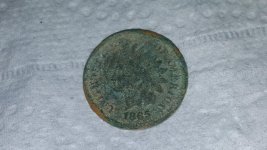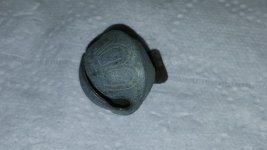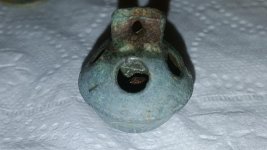You are using an out of date browser. It may not display this or other websites correctly.
You should upgrade or use an alternative browser.
You should upgrade or use an alternative browser.
Another field hunt, one keeper and a bucket lister
- Thread starter Digger_O'Dell
- Start date
aloldstuff
Moderator
Congrats on that IH and even bigger congrats on your 1st crotal bell.
Digger Don
Active member
Congrats on the old Indian and cool crotal Bell.
Glad to see your still getting some hunts in before the ground freezes.
Glad to see your still getting some hunts in before the ground freezes.
Digger_O'Dell
Active member
Thanks Al!
Frozen ground is the last thing I'm worried about, after all the rain I was having trouble staying afloat in all the mud, and walking with the extra 10 pounds of the stuff on each boot. Lol
This was my 2nd 1865 IH from this field. Right now 3/4 of the field is still planted with soy beans and apparently an abandoned rope since so much of it is stunted and probably not worth picking. Still no good good for swinging except in the sparsest areas of the beans. Might be much better in spring after the snow mats down the unharvested beans. There has to be a lot more out there that I just can't get to yet.
Congrats on the old Indian and cool crotal Bell.
Glad to see your still getting some hunts in before the ground freezes.
Frozen ground is the last thing I'm worried about, after all the rain I was having trouble staying afloat in all the mud, and walking with the extra 10 pounds of the stuff on each boot. Lol
This was my 2nd 1865 IH from this field. Right now 3/4 of the field is still planted with soy beans and apparently an abandoned rope since so much of it is stunted and probably not worth picking. Still no good good for swinging except in the sparsest areas of the beans. Might be much better in spring after the snow mats down the unharvested beans. There has to be a lot more out there that I just can't get to yet.
Lodge Scent
Active member
A nice crotal bell. Congrats! All I find are smashed ones.
wisconsin digger
Active member
Nice hunt, you tide my count on Crotal Bells. they are a neat find. Congrats
Digger_O'Dell
Active member
Thanks Jim! I'm really happy it's not only intact and perfect, but the pellet is also inside even though it's a bit crusty. It makes a really nice jingle!
Digger_O'Dell
Active member
Nice hunt, you tide my count on Crotal Bells. they are a neat find. Congrats
So am I to believe that crotal bells are that rare in Wisconsin? I know from researching that the one I found is probably a later version dating from around 1750 to 1850, but I figured they would stay in use for many many years, or even many generations. They may be used a lot but not be lost until they are well over 100 years old.
The indicator I have is that the field I'm hunting has given up nothing but either very recent drops from the city gardeners or the very old drops, namely the very early IHs. Maybe I'll have to name this place the 1850 field.
Last edited:
Ill Digger
Moderator
Nice old IH Chris!
And of course a big congrats on your first crotal bell!:congrats:
And of course a big congrats on your first crotal bell!:congrats:
groundhog53946
New member
Way to go Chris! Your having a good year!
Sent from my XT830C using Tapatalk
Sent from my XT830C using Tapatalk
MangoAve
New member
Thanks Jim! I'm really happy it's not only intact and perfect, but the pellet is also inside even though it's a bit crusty. It makes a really nice jingle!
I do wonder if my bigger/est (idr exactly) would have a better sound if the dinger wasn't rusted. The dingers for almost all the crotals were iron, whilst the conestoga were either brass or iron. Just they all hung on an iron wire regardless. The smaller ones still make a nice jingle too. Maybe you can make an xmas wagon with that bell for the winter season.
So am I to believe that crotal bells are that rare in Wisconsin? I know from researching that the one I found is probably a later version dating from around 1750 to 1850, but I figured they would stay in use for many many years, or even many generations. They may be used a lot but not be lost until they are well over 100 years old.
The indicator I have is that the field I'm hunting has given up nothing but either very recent drops from the city gardeners or the very old drops, namely the very early IHs. Maybe I'll have to name this place the 1850 field.
I think I became the bell expert on AD. (Idk how much more that the woman who bids for White's knows than I do). Judging by the other post you have I am going to have to trim date ranges down a tad. But... Petal bells, such as yours, were started around 1795, not 1750, altho there is some exactness to the starting of the foundry. They are more common in the eastern part of the US for a few reasons. Population density was just as comparable in the 1800s as it is now. More people = more bells being around. I'm sure it is understood that I am talking about more family names vs size of families... That as well as the fact CT had the most bell foundries in the US at the time. That's the reason they are more concentrated in the NE. One particular one I had back in one of my posts was 1837-1851 had a cast shank. The drilled shanks came later on. The Seth North one I had was also a cash shank, which that foundry was 1832-1850. Pretty much 1778-1790s and cast shank is a regular crotal. One made 1790s to 1840 has a cast shank with a petal design. Something 1840-1870s would have a drilled shank. Something 1870s-1890s would have an iron top (some sort of shank). And Then 1880s would be the conestoga type.
Digger_O'Dell
Active member
Thanks for the info Jim! The dates I got were off an England Web site, but generally parallels the American versions.
As for cast vs drilled shank, I cleaned the rust scale off my bell and found it is a cast type shank with the rectangular hole.
As for cast vs drilled shank, I cleaned the rust scale off my bell and found it is a cast type shank with the rectangular hole.
MangoAve
New member
Thanks for the info Jim! The dates I got were off an England Web site, but generally parallels the American versions.
As for cast vs drilled shank, I cleaned the rust scale off my bell and found it is a cast type shank with the rectangular hole.
Yeah, the English were the ones making them earlier on as obvi Europe has more history behind it than the US does. Historical info here is spotty before 1650 other than the few things known about Native Americans. So they made bells in Europe for much longer. Are you sure? It looks drilled to me form pic. Ill have to take a few pics of tops and post them here to see the difference. The GAW one I have isn't even straight on the top and the shank has more of a slot than a hole. The drilled one is almost an angled hole. You'll see what I mean later.
Digger_O'Dell
Active member
I'll post a pic of the cleaned shank this evening when I get back to work. You'll see the nice rectangular casting.
MangoAve
New member
Okay, so there is one correction. The Seth North Bell is actually drilled so it is closer to the 1850 mark than the 1832 mark. There was only 18 years in there anyway. This is all the big bells. The two GA&W had the cast shank. The N&S had the drilled shank. And the one at 7 o'clock is the smaller conestoga. The larger still had the iron loop in it so I took the pic of the smaller as it showed the drilled hole better. That cast shank of the GA&W was closer to 1837. You can obvi tell the overlapping time frame for both foundries.
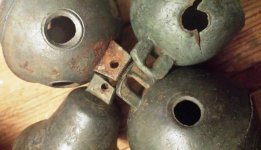
These are the midsize ones. The cast one is again a part of the GA&W set. Of the others, one is a petal bell and one is regular Both have a drilled shank.
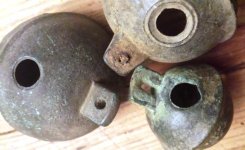
These are the smaller type of bells. The 8 0'clock one is definitely drilled. I believe the one at 2 0'clock is as well, but it is a tad rusted. I did use vinegar as you can see it is shiny, but vinegar works differently on iron than it does the brass tin alloy the bell is made of. The 5 o'clock might be cast as it kinda looks like a slot. Its hard to tell, tho, as it was broken off. Weird it would have broken AND have the iron with it, defying logic there. The one at 11 0'clock is the odd one that I say is much later on close to the 1870s. Maybe even 1880s. You can see a round base for where it attached. I don't even know if it was a shank anymore by that time.
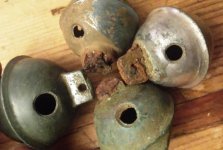
This is the absolute smallest one I have. I had to include it because of the completely different way it attached. Those two nubs are NOT broken pieces from a shank. The resonator holes aren't even fully a hole. The nubs are smooth and the same height. It was just how it was cast. Maybe it was a riveted or rolled edge of a wire that went through that hole to hold it on. They prob had a punch that was slotted and accessed through that slot in the bottom. Note this was found along with the other GA&W, at least at the same site.
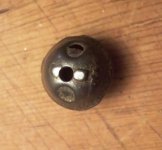

These are the midsize ones. The cast one is again a part of the GA&W set. Of the others, one is a petal bell and one is regular Both have a drilled shank.

These are the smaller type of bells. The 8 0'clock one is definitely drilled. I believe the one at 2 0'clock is as well, but it is a tad rusted. I did use vinegar as you can see it is shiny, but vinegar works differently on iron than it does the brass tin alloy the bell is made of. The 5 o'clock might be cast as it kinda looks like a slot. Its hard to tell, tho, as it was broken off. Weird it would have broken AND have the iron with it, defying logic there. The one at 11 0'clock is the odd one that I say is much later on close to the 1870s. Maybe even 1880s. You can see a round base for where it attached. I don't even know if it was a shank anymore by that time.

This is the absolute smallest one I have. I had to include it because of the completely different way it attached. Those two nubs are NOT broken pieces from a shank. The resonator holes aren't even fully a hole. The nubs are smooth and the same height. It was just how it was cast. Maybe it was a riveted or rolled edge of a wire that went through that hole to hold it on. They prob had a punch that was slotted and accessed through that slot in the bottom. Note this was found along with the other GA&W, at least at the same site.

Digger_O'Dell
Active member
Great info, very cool pics too! It was crazy around work and forgot to take a pic. But my shank looks like yours in the top pic, right side. Thanks for the post!
Digger_O'Dell
Active member
Thanks Dan!
